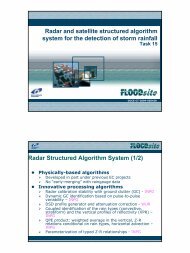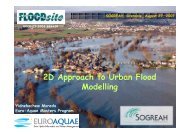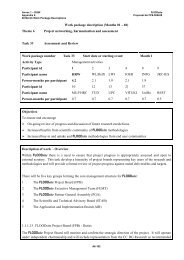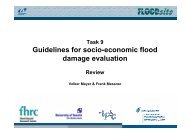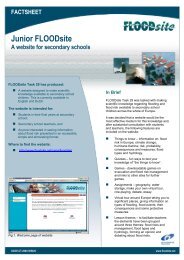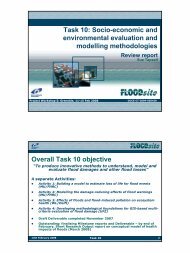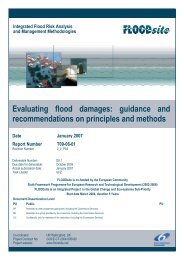Evacuation and traffic management (full report) - FLOODsite
Evacuation and traffic management (full report) - FLOODsite
Evacuation and traffic management (full report) - FLOODsite
Create successful ePaper yourself
Turn your PDF publications into a flip-book with our unique Google optimized e-Paper software.
Task 17 <strong>Evacuation</strong> D17-1<br />
Contract No:GOCE-CT-2004-505420<br />
of another Category 1 responder, then it too has a duty to warn. The Environment Agency provides<br />
warnings as much to other responders, who must take decisions on, for example, evacuation, as it does<br />
to the public. Category 1 responders will generally identify <strong>and</strong> agree that the Environment Agency<br />
should be the lead responder for warning, informing <strong>and</strong> advising the public.<br />
During a flood incident, the Environment Agency is committed to undertaking the following actions:<br />
• Issue timely flood warnings to those at risk <strong>and</strong> to operational organisations in accordance with the<br />
Environment Agency’s customer charter, by constant monitoring of weather, catchment <strong>and</strong><br />
coastal conditions, prediction of future river <strong>and</strong> sea levels, preparation of warnings for locations<br />
at which forecast or actual levels might result in flooding <strong>and</strong> dissemination of warnings;<br />
• Work in co-operation with professional partners to ensure a seamless <strong>and</strong> integrated response to<br />
flood incidents, including advising the police on the need to declare a major civil emergency <strong>and</strong><br />
providing representatives to the various emergency control points;<br />
• Manage its reputation by proactive <strong>and</strong> reactive actions to protect <strong>and</strong> enhance the Agency’s<br />
reputation during a flood incident;<br />
• Collect <strong>and</strong> record data during a flood incident in accordance with the National Flood Data<br />
Collection Manual e.g. flood levels, flows <strong>and</strong> extent; number <strong>and</strong> depth of property flooding;<br />
• Monitor <strong>and</strong> inspect the flood defence system against design st<strong>and</strong>ards of defence <strong>and</strong>, at<br />
undefended flood-prone communities to <strong>report</strong> on incidents of actual or likely failure <strong>and</strong> so<br />
enable emergency action to be assessed <strong>and</strong> undertake;<br />
• Undertake a reactive response to minimise the risk of failure of flood defence assets, remedial<br />
action upon failure of flood defence assets <strong>and</strong> mitigation measures to limit the extent <strong>and</strong> damage<br />
of flooding during an incident;<br />
• Erect/install temporary defences to limit the extent <strong>and</strong> damage of flooding to an undefended<br />
community or individual property;<br />
• By local agreement, once it has ensured that its own systems <strong>and</strong> defences are secure, support the<br />
police, local authorities <strong>and</strong> reservoir undertakers via the multi-agency comm<strong>and</strong> <strong>and</strong> control<br />
structure to the extent that their resources (materials, equipment, manpower) <strong>and</strong> other duties<br />
permit;<br />
• Participate in flood incident contingency planning at Local Resilience Forum <strong>and</strong> lead/support the<br />
flood-related subgroups.<br />
(Environment Agency 2005b, HM Government 2005a, 2005b)<br />
Local Authorities<br />
Local Authorities play a critical role in civil protection. Local authorities maintain a small hub of<br />
planners who co-ordinate <strong>and</strong> facilitate emergency planning <strong>and</strong> response work across the authority.<br />
They have key statutory responsibilities for environmental health, housing, social services <strong>and</strong><br />
highways <strong>and</strong> exercise a community leadership role. Local Authorities work with the police, fire <strong>and</strong><br />
rescue services <strong>and</strong> the Environment Agency to co-ordinate the response during severe flooding.<br />
(Environment Agency 2005b, HM Government 2005a, 2005b)<br />
Police forces<br />
Police forces co-ordinate response to most l<strong>and</strong> emergencies, including flooding. In particular, they<br />
will co-ordinate the activities of responders at <strong>and</strong> around scene of a l<strong>and</strong>-based sudden-impact<br />
emergency.<br />
Fire <strong>and</strong> rescue authorities<br />
Fire <strong>and</strong> rescue authorities co-ordinate search <strong>and</strong> rescue activities. Their responsibilities include:<br />
• Working with the police <strong>and</strong> others to plan for flood emergencies;<br />
T17_07_02_<strong>Evacuation</strong>_<strong>and</strong>_<strong>traffic</strong>_<strong>management</strong>_D17_1_V4_4_P01.doc 19 03 2008<br />
10




